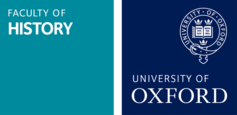Muslim Students and their Society: An Ongoing Memory
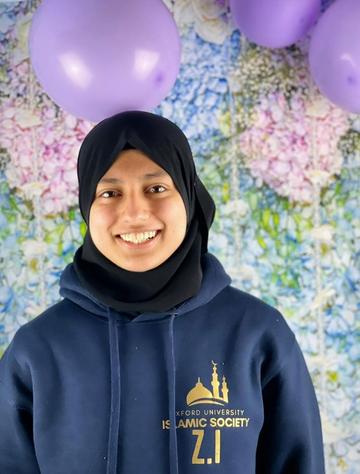
Zuhaira Islam
This piece is written by Zuhaira Islam, a BA History & Politics student at St Peter’s College. Zuhaira was one of the first interns on the Faculty’s Community History initiative, working on the collaborative project, ‘The History of Muslims in Oxford’ together with our community partner, Everyday Muslim. Zuhaira is the incumbent President of Oxford University’s student Islamic Society.
The Oxford University Islamic Society (OUISoc) has a rich and diverse history. Since the mid-twentieth century, it has served tirelessly in catering to Muslim students of a range of rich and diverse backgrounds. Bringing them a place to practise their faith, like-minded companions and a sense of belonging in the oft-alien environment that is university, the society has long since been a thriving and welcoming community. As we embark upon its 64th year of existence (and 40th year of official recognition), I thought it opportune to reflect upon some key moments in its timeline and to recognise the lasting and positive impact it has had. In this article I will explain how, as an intern researching Muslims in Oxford alongside the History Faculty, my interest focused on the OUISoc. I will also go on to showcase some of my findings and give a brief glimpse into the content of the Society Archives, preserved in the Weston Library.
Oxford’s local Muslim community is a melting pot of individuals originating from a plethora of different cultures, involved in all aspects of society. In starting the internship, my focus quickly turned to the academic community: scholars and students. This was an area that I myself could entirely relate to. To look back with fondness upon forgotten memories, to commemorate a society which through the everyday rush and fervour of University life has cemented itself at the heart of many students’ experiences, became the motivation behind this research. Indeed, celebration is one of the true purposes of History - a fact that became clear to me over the last few months’ work.
The material in the OUISoc Archives is extensive. Many visits were paid to get a sufficient grasp of the weight of the information they held. This article will illustrate the importance of some of these resources: taking a chronological glance through the records to offer a whistle stop tour through its defining moments.
Image one
The oldest document on display in the Archives, showing the Islamic Union (a precursor of the ISoc) has existed since at least 1958. The simplicity of the front cover demonstrates the recency of its establishment – there existed no formal name nor logo. However, its existence since 1958 is significant in that it denotes a demand for an establishment which represented Muslim students, and allowed for their voices to be heard and needs to be catered to before this year.
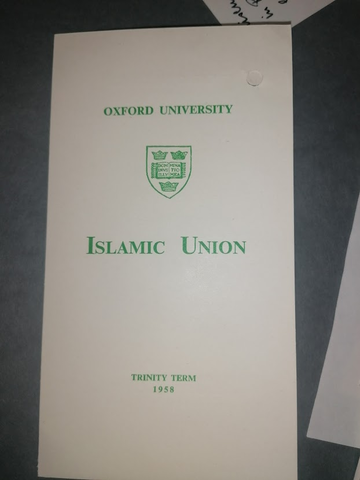
Image two
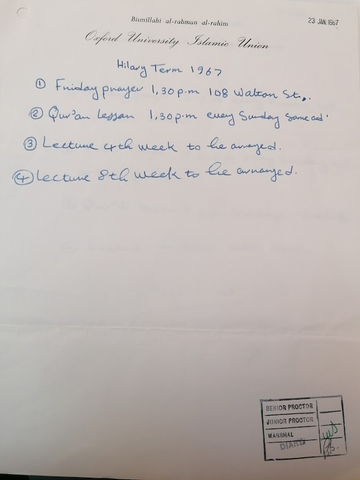
Before the introduction of Term Cards, the Society would send out weekly bulletins of all the events happening to its membership. The Marshal’s signature in the corner indicates that these activities were official and recognised.
This particular one dates to Hilary Term 1967, however they existed before and continued long after. This document long pre-dates the foundation of the Muslim Prayer Room, as highlighted by the location of Friday Prayers being given as 108 Walton St. The significance of the Muslim student community having a place they could offer their Friday Prayers as far back as the 1960s cannot be overstated.
However, as the community grew, a larger space was required and thus, in 2011, a motion was submitted which led to the establishment of the Muslim Prayer Room, located in the Robert Hooke Building, as we presently know it.
(NB: In the present day, a popular Tandoori restaurant, Jamal’s is located at this Walton Street address.)
Image three
The President's letter which states that the Oxford University Islamic Society was formally established in 1982. It shows the transition from the Society being one which primarily focused on the facilitation of a weekly prayer and
lectures, to one which held a far broader, overarching purpose of being the unifier of the Muslim community. It marks the transition from Union to Society and is an indicator of when the society became an officially recognised
body by the University. An interesting point of note in this letter is the intention of it being a place for both ‘Muslims and Non-Muslims to meet,’ one which has translated itself into the present day. It clearly outlines that
the society was not created to be exclusionary, but moreover to provide a forum in which like-minded people could meet.
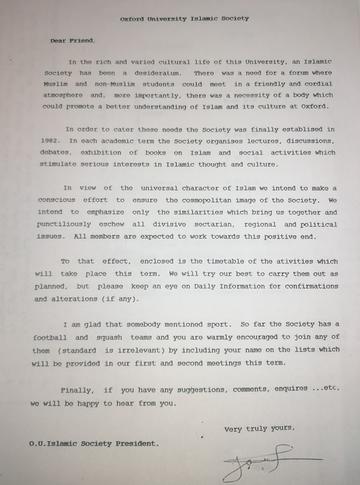
Image four
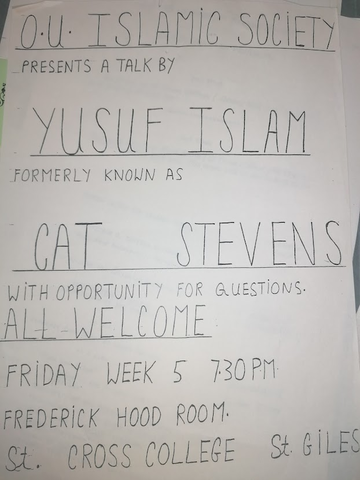
A handwritten advertisement showing Cat Stevens' lecture to the society- dated 1986. Even for such a high-profile event as this, printed posters were not used. This is suggestive of the informality of the society in 1986. The informality is also indicative of the small nature of the ISoc at this point – it was not such a large body of people that necessitated a requirement for events to be professionalised and streamlined.
The invitation to Cat Stevens’ event also highlight the popular culture of the time. The British singer-songwriter’s reversion to Islam had occurred less than a decade prior and was still relatively recent. Furthermore, it coincided with the height of his popularity, meaning that for the ISoc to host him must have been a keynote event; perhaps the most significant/memorable since it had been established.
(It is interesting to note that the room this lecture was held in no longer seems to exist, although the main site of St Cross College remains on St Giles, Oxford.)
Image five
An informative guide for Muslim students has been published each year, detailing locations of key prayer spaces, Halal food and other key details for the community. The dates of the ones in the above image vary from 1991-1999. The designs maintained consistency throughout this period and beyond committee descriptions, the internal content also did not differ between years.
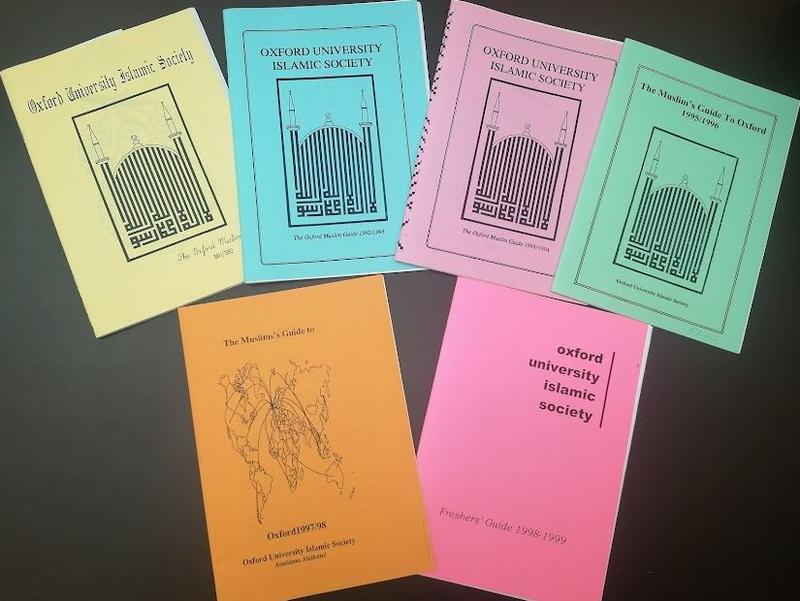
Image six
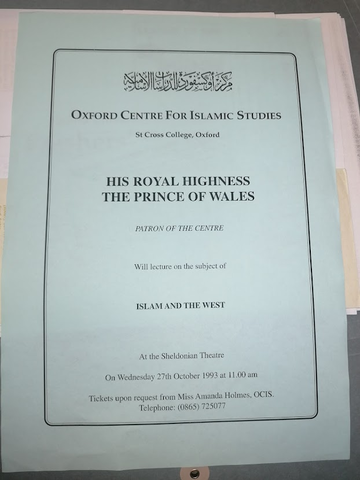
Located in the Archive, this image shows an advertisement of the Prince of Wales paying a visit to the Oxford Centre for Islamic Studies, in 1993. The Prince is a Patron of the Centre and thus has a longstanding connection to the Muslims of the city, specifically the Muslim academic community.
Image seven
This booklet detailing the importance of women in Islam (and also the Society) was published in 2002, emphasising the society’s longstanding stance on equality.
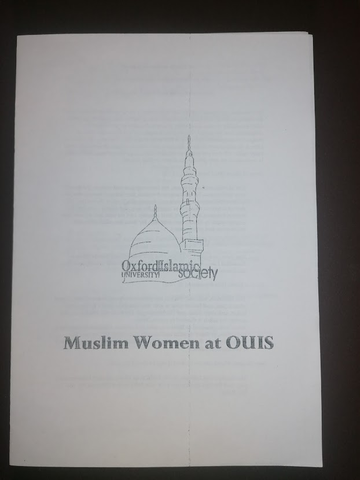
Image eight
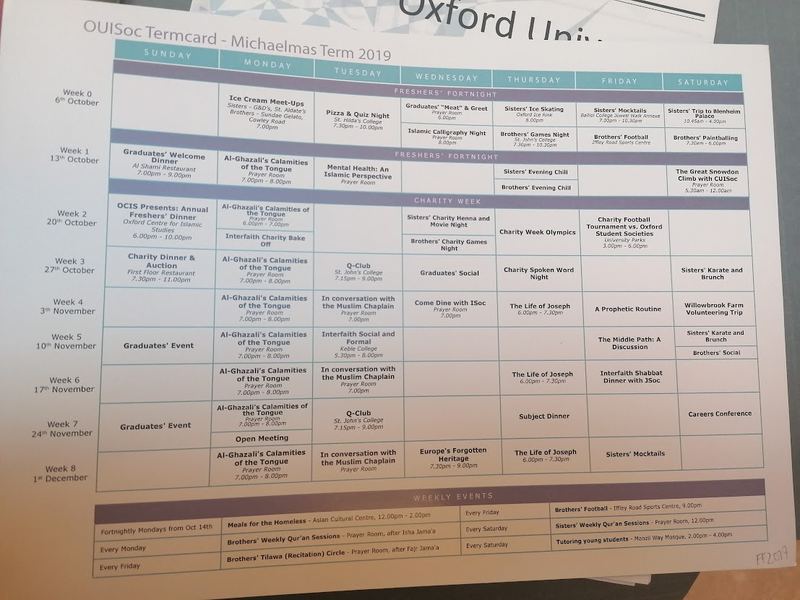
One of the more recent documents in the Archive (2019). It showcases how the ISoc has blossomed into a society with a regular timetable of events planned for the term. We can see the society return cyclically back to its statement of foundation and exhibit a marked range of events. These varied from social gathering to foster the growing sense of community, philosphical lecture series on Al-Ghazali to enhance the spiritual aspect and even an interfaith formal, bringing people of all faiths and none together in an act of celebration.
The pictured document also displays the gradual increase in events. From having two large scale events in Hilary Term 1967 (as documented above), to having at least four varied events per week in Michaelmas 2019, the comparative study serves to fully demonstrate just how far the society has come in terms of being active and catering to a far-reaching demographic.
If this article has indicated one thing it is that history is a study of the past but also of the future. It shows us that the last half a century of a society flourishing within Oxford has laid the groundwork for it to continue to expand and enrich all its members in the future. As the OUISoc and the general community continue to grow, it is imperative that we trace their achievements and recognise them accordingly. For myself, the last seven months of research has led precisely to this, a celebration of the Muslim students of Oxford and an ode to their future.
